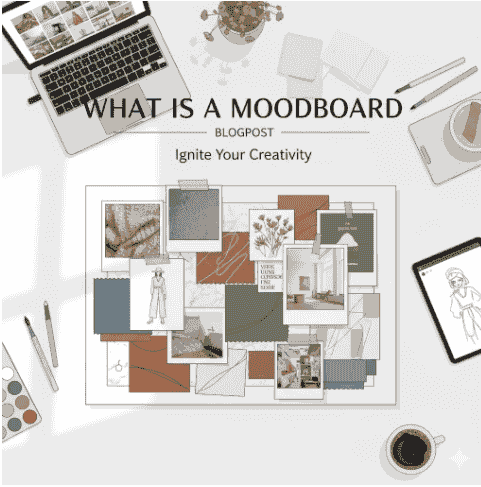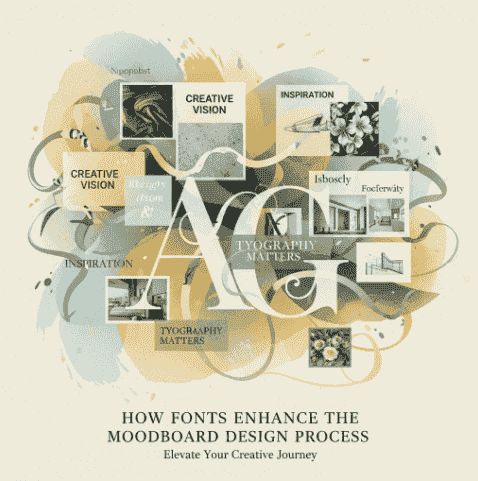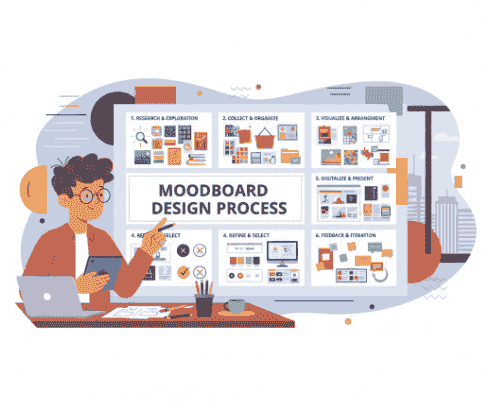Table of Contents
- Introduction: Why Moodboards Matter in Design
- What is a Moodboard?
- The Moodboard Design Process Step by Step
- Step 1: Define Your Project Goals
- Step 2: Collect Inspiration
- Step 3: Choose a Color Palette
- Step 4: Select Fonts and Typography
- Step 5: Add Imagery and Textures
- Step 6: Organize and Refine Your Moodboard
- Digital vs. Digital Physical Moodboards
- Best Tools for Creating Moodboards
- How Fonts Enhance the Moodboard Design Process
- Examples of Moodboards in Branding & Marketing
- Conclusion
1. Introduction: Why Moodboards Matter in Design
In today’s fast-paced creative industry, visual communication is more powerful than ever. One essential tool that designers, marketers, and entrepreneurs rely on is the moodboard design process . A moodboard acts as a visual roadmap for your project, helping you organize colors, fonts, textures, and imagery to define the overall style and direction. Whether you’re building a brand identity, creating a website, or planning a marketing campaign, moodboards ensure that your vision stays consistent.
2. What is a moodboard?
A moodboard is a curated collection of images, typography, color swatches, and design elements that communicate a specific mood or theme. Think of it as a collage of inspiration that sets the visual tone for your project. Designers often use moodboards to present ideas to clients or to stay aligned with their creative vision.
For example, a wedding stationery designer might create a soft pastel moodboard, while a streetwear brand might use bold fonts and grunge textures.

3. The Moodboard Design Process Step by Step
Step 1: Define Your Project Goals
Before creating your moodboard, clarify your project objectives. Are you designing a logo , a social media campaign , or a website layout ? Knowing your goals will guide every choice you make.
Step 2: Collect Inspiration
Browse platforms like Pinterest, Behance, and Dribbble to gather inspiration. Save anything that resonates with your theme: photography, packaging, artwork, or typography.
Step 3: Choose a Color Palette
Colors set the emotional tone of your design. For example:
- Warm tones → evoke energy and passion
- Cool tones → communicate calmness and trust
Use free tools like Coolors.co to generate palettes.
Step 4: Select Fonts and Typography
Typography is one of the most important elements in moodboard creation. The right font instantly communicates style—modern, playful, elegant, or bold.
👉 On RaisProject, you can explore fonts like:
- Elegant Handwritten Script Fonts – perfect for wedding moodboards.
- Bold Display Fonts – ideal for urban or streetwear projects.
- Modern Serif Fonts – great for editorial and luxury branding.
Step 5: Add Imagery and Textures
Images, photography styles, and textures give depth to your moodboard. For example, linen textures can suggest organic branding, while metallics suggest luxury.
Step 6: Organize and Refine Your Moodboard
Arrange your elements into a balanced composition. Place the primary inspiration (fonts, colors) at the center and supporting visuals around it. Keep refining until everything aligns with your project’s personality.
4. Digital vs. Internet Physical Moodboards
- Digital Moodboards : Faster, editable, and perfect for online sharing. Popular tools include Canva, Milanote, and Adobe Express .
- Physical Moodboards : Great for tactile projects like fashion design, where fabric swatches or paper samples can be included.
5. Best Tools for Creating Moodboards
Some of the most popular digital tools are:
- Canva – beginner-friendly with drag-and-drop features.
- Milanote – designed specifically for creative moodboards.
- Figma – excellent for collaborative design projects.
6. How Fonts Enhance the Moodboard Design Process
Fonts aren’t just decorative—they define personality. For instances:
- A script font conveys elegance and romance.
- A bold sans serif conveys strength and modernism.
- A serif font conveys sophistication and authority.
👉 Browse RaisProject Fonts to find typography that fits your moodboard style.

7. Examples of Moodboards in Branding & Marketing
- Luxury Fashion Brand → Black and gold palette, serif fonts, high-end textures.
- Playful Kids Brand → Bright pastel colors, rounded fonts, whimsical illustrations.
- Minimalist Tech Startup → Neutral tones, geometric sans-serif fonts, clean layouts.
Each example shows how the moodboard design process can drastically shape the final identity.
8. Conclusion
The moodboard design process is more than just a collection of visuals—it’s the foundation of your creative project. From choosing colors to selecting fonts, every element plays a role in shaping your brand’s identity.
If you want your moodboards to stand out, start by investing in the right fonts that speak your brand’s language. Explore our curated font collections at RaisProjectand take your design projects to the next level.
🔗 References
- Letterhend: The Importance of Moodboards in Design
- Canva: How to Create a Moodboard
- Milanote: Moodboard Guide

